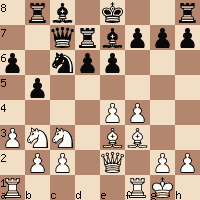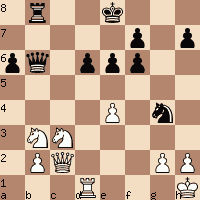Key Points
- An Incredibly Resourceful Knight
- Every Move Creates a Weakness
1.e4 c5 2.Nf3 Nc6 3.d4 cxd4 4.Nxd4 Qb6 5.Nb3 Nf6 6.Nc3 e6 7.Be3 Qc7 8.a3 a6 9.f4 d6 10.Be2 b5 11.Bf3 Rb8
A strong move that prepares classic Sicilian counterplay and gets away from the threat of 12.e5.
12.0–0 Be7 13.Qe2 Nd7
An Incredibly Resourceful Knight
This knight retreat is played frequently in the Sicilian, because it has great prospects from d7. Let’s look at all the different purposes it serves
White must advance with either e5 or f5 to make progress in this position. Nfd7 overprotects e5, and makes it very difficult for White to consider that advance.
On the other hand, if White plays f5, the knight will have a great central post on the e5 square.
In many variations of the Sicilian, Black plays Nb6–c4, and this can be a very powerful maneuver, especially if White castles queen side.
Depending on how White plays, it’s often best for Black to post on c5, on order to pressure the e pawn.
Sometimes White builds pressure against Black’s King side by playing Rf3–h3 and Qh5, threatening mate on h7. In these lines, Black can Nf8 to hold h7, and it is often the perfect defensive resource.

14.Rad1
This move demonstrates a lack of understanding. White is completely unable to create any kind of real pressure against d6. In these positions, he needs to play for a King side attack.
Play in the Sicilian is typically sharp because of the imbalanced pawn structure. It’s especially important to pursue the right plan in sharp positions, because it can be difficult to contain your opponent’s counter play, and he will often take over the initiative after a couple of small inaccuracies.
14...0–0 15.Bg4 b4 16.axb4 Nxb4 17.f5
Every Move Creates a Weakness
This is a key point in the contest. White threatens 18.exf6. That means the knight has to move, and it’s much stronger in the middle of the board.
However…
I was aware that 17...Ne5 abandons control of f6, and was concerned about an exchange sacrifice on that square.
If that sacrifice worked then 17...Ne5 would be exactly the kind of tactical mistake that costs games, as we often don’t pay enough attention to our opponent’s threats.
However, concrete analysis clearly proved that I had all the resources necessary to defend against all attacking ideas.
17...Ne5 18.f6
He plays the sacrifice!
18...Bxf6 19.Rxf6 gxf6 20.Bh6 Rd8
20...Nxc2 was more accurate. The reason it works so well is because Black’s position is so well coordinated, his pieces are extremely active, and White has so many problems.
Here’s the first variation the computer gives ... 21.Bxf8 Qb6+ 22.Kh1 Kxf8 23.Qxc2 Nxg4.

21.Bh3 Kh8
Eliminating potential checks and preparing the knight file for the rook.
22.Rf1 Nxc2 23.Qxc2 Qb6+ 24.Kh1 Qxb3 25.Qf2 Nd7
The heroic knight continues to play a key role in almost every variation.26.Qg3 Rg8 27.Qxd6 Qc4 28.Qf4 Rg6 29.g3 Rxb2 30.Nd1 Rb1 31.Ne3 Rxf1+ 32.Bxf1 Qc1 33.h4 e5
This move wins the bishop, so White resigned.
